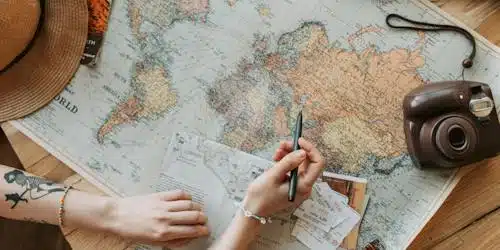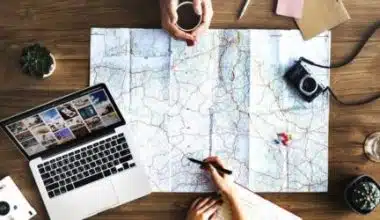While planning a trip to Japan is undoubtedly wonderful, it also likely causes a great deal of excitement and anxiety. Japan has always seemed to me to be somewhere different. T
The language is challenging. There is a whole culture that is nearly impossible for a foreigner to understand. It’s known as tatemae in Japan. This term, which has virtually no equivalent in English, refers to the Japanese practice of attempting to avoid upsetting anyone.
Japan’s combination of the ancient and modern is fascinating, and a single visit won’t give you a full understanding of this intricate nation.
Japan felt quite foreign to me, as I suppose it may well feel to you, even though I spent hours planning for my first trip there. Every visit here seems to me like an opportunity to discover a little bit more about what makes Japanese culture so fascinating.
This is all I’ve learned about trip planning in Japan, whether you’re just daydreaming about your first visit or you’re about to schedule your tickets. Everything is available here, including where to travel, where to stay, and what to do!
Planning Trip to Japan
It’s a good idea to decide on your schedule and research lodging and transportation alternatives for each location ahead of time when organizing a vacation to Japan.
A comprehensive collection of travel advice when planning a trip to Japan can be found below, along with information on using a JR Pass, learning common words and basic Japanese etiquette, and how to get WiFi in the nation.
#1. Accommodation
Staying in a sleep pod at a Japanese capsule hotel is a great choice if you’re on a tight budget when visiting Japan.
Despite being smaller than a typical hotel room, the sleeping pods in these unusual “pod hotels” are typically incredibly contemporary and comfortable, and some even have opulent amenities like spas and saunas.
If you’re ready to pay a little bit extra to stay in a traditional Japanese place, you should think about booking a Ryokan (Japanese guest home).
For the authentic Japanese experience, many travelers believe that a Ryokan is worth the slight price difference (usually between ¥15,000 and ¥25,000 per person, per night) compared to a standard hotel.
#2. JR Pass
Anyone visiting Japan who intends to travel around the country needs to have the Japan Rail Pass.
The reduced JR Pass is a multi-use ticket that offers unlimited access to Japan Rail National trains in addition to JR bus, ferry, and airport transfers.
Even if you don’t intend to go far within the nation, the Japan rail pass is still worthwhile to purchase because it offers a more affordable choice for traveling the entire length of the nation than a single Shinkansen bullet train ticket from Tokyo to Kyoto.
#3. IC Cards
Consider applying for a Japanese IC card, a prepaid rechargeable travel card that may be used on buses, trains, metros, ferries, and cable cars within the city, if you don’t intend to leave Tokyo during your visit.
Additionally, several restaurants, convenience stores, and vending machines around Japan accept IC cards. Any major train station, automated kiosk, or ticket counter will sell IC cards.
#4. Travel Schedules
There are many thorough Japanese routes and itineraries available to assist you in seeing everything you want to see when planning your trip, whether you are going to be in Japan for a week or up to a month.
#5. Phone and Internet Access
There are several options for visitors to Japan to get internet access. Downloading the Japan Connected phone app is a smart idea once you’re in the nation since it shows you where the more than 1,500 hotspots in Japan offer free WiFi.
#6. Decide on the Duration of Your Trip
There is a lot to see and do in the diverse nation of Japan. Take into account the amount of time you have for your travel. A two-week trip would ideally allow you to see a good variety of locations, but you can also alter your schedule to fit your interests and time constraints.
#7. Research and Choose Your Destinations
Japan has many different places to visit, each with its own special appeal. Tokyo, Kyoto, Osaka, Hiroshima, Nara, and Hokkaido are among the most often selected cities. Take into account your areas of most interest and adjust your itinerary accordingly.
#8. Determine the Best Time to Visit
There are four distinct seasons in Japan, and each offers a distinctive experience. Cherry blossoms are seen in spring, vivid foliage is seen in fall, heat and humidity are present in summer, and winter brings winter activities to those in the north. You must schedule your visit appropriately.
#9. Create a budget.
Japan may not be the most affordable travel destination. Determine how much lodging, transportation, food, and attractions typically cost, then set aside that amount of money. To reduce your meal costs, think about booking inexpensive lodging like guesthouses or capsule hotels and dining at neighborhood restaurants or street food vendors.
#10. Acquire Rudimentary Japanese Vocabulary
Even though English is widely spoken among Japanese people, knowing a few basic Japanese phrases will always improve your vacation experience. To establish rapport and demonstrate respect, small gestures like please, thank you, and goodbye can be quite helpful.
Requirements for a Trip to Japan
There are a few things to consider before planning a trip to Japan.
Among them are:
#1. Passport and Visa Requirements
Make sure your passport is still valid for the whole time you plan to visit Japan. Many nationalities are eligible for visa-free entrance for stays of up to 90 days as tourists or business travelers. It is imperative to verify the specific visa requirements associated with your nationality.
#2. Carrying Identification
Make sure you always have your passport with you when visiting Japan. It’s required by law, and the local police might ask to see your identification. Make sure your passport is valid for the entire length of your trip, and research the validity requirements and visa requirements of any additional countries you intend to visit.
#3. Lost or Stolen Passports
The American Embassy in Japan can help you obtain a new passport if your old one is stolen or misplaced. Speak with the embassy for advice and assistance.
#4. Possession of Prohibited Items
Understand the rules and legislation about things that are prohibited in Japan. It is against the law in Japan to carry weapons, ammunition, knives with locking blades or folding blades longer than 5.5 cm, as well as lock-picking gear. Learn the regulations so that you don’t run into any legal problems.
#5. Arrest Notification
Ask the police or jail officials to promptly contact the U.S. Embassy if you are arrested or detained in Japan. In these circumstances, they can offer support and assistance.
#6. Health Insurance
Getting international travel medical insurance for your trip to Japan is highly advised during the planning of your trip to Japan. This insurance covers any medical expenses or unexpected emergencies that may arise while you are there.
#7. Transport
Trains, subways, and buses are all part of Japan’s well-functioning transportation network. Get acquainted with the available modes of transportation and contemplate acquiring a Japan Rail Pass in case you intend to visit several places. Verify train timetables, subway maps, and passes for public transportation to ensure a convenient and hassle-free domestic journey.
#8. Security and Safety
In general, traveling to Japan is safe. Nonetheless, it’s always a good idea to follow standard security procedures and keep up with any potential dangers or safety issues. Keep abreast of travel advisories and heed local authorities’ recommendations when planning your trip to Japan.
#9. Medical and Health Facilities
Although there are first-rate medical facilities in Japan, it is still necessary to get travel medical insurance to cover any unexpected medical costs. Make sure you have all the prescriptions you need with you and find out whether you require any shots before visiting Japan.
#10. Regulations Concerning Customs
Become familiar with Japanese customs regulations. Some substances are severely forbidden, such as narcotics and weapons. Observe the guidelines to steer clear of any legal problems when traveling.
Where to Go in Japan
Even though I strongly advise going off the beaten path, traveling to Japan for the first time can be intimidating. There is a true language barrier, and society is considerably different from what many of us are used to.
Particularly if this is your first trip to Japan and you’re planning on your own, you’ll discover that Japan’s big cities are more user-friendly and more suited for foreign tourists.
Conversely, a few of the smaller towns and cities provide an entirely different experience.
My suggestions for a first-time visitor to Japan are as follows:
#1. Tokyo
Tokyo is big, colorful, and exciting. The largest metropolis in Japan offers a plethora of activities. With 40 million residents, it’s the largest city on Earth!
From Tokyo, you may take several fantastic day trips, such as to Hakone and Mount Fuji (no explanation needed), Kawagoe and Kamakura (excellent for history buffs), and Nagano (home of the snow monkeys).
#2. Osaka
Japan’s indisputable culinary epicenter is a fantastic location to experience Japanese cuisine in its purest form, along with a dash of culture. Try the okonomiyaki (savory pancakes), fugu puffer fish, and takoyaki (octopus balls) in the Dotonburi neighborhood.
After you’ve exhausted yourself, you can go to shrines and temples or spend a few days traveling outside of the city. It’s simple to travel from Osaka to Hiroshima, Miyajima, and Nara, the historic capital best known for its deer park.
#3. Kyoto
The closest you’ll likely go to Japan’s spiritual center is in its ancient capital. Every year, around one-third of all Japanese people travel to Kyoto.
The renowned Fushimi Inari shrine, the Gion Geisha area, the stunning Kinkaku-ji (Golden Pavilion), and an abundance of temples to occupy your time may all be found here. Kyoto is a fantastic place to learn about and experience Japanese culture.
Day visits to Nara, the historic Himeji castle, and Arashiyama, home to the Instagram-famous bamboo forest and Iwatayama monkey park, are all doable from Kyoto.
#4. Hiroshima and Miyajima
Easily one of the most poignant locations in Japan, if not the entire globe, Hiroshima ought to be on the itinerary of every traveler visiting the country for the first time. Although visiting the Peace Memorial Park and Museum is not simple, I firmly believe that the more people who do so, the fewer times we will likely repeat the mistakes of the past.
Miyajima, with its adorable map-eating deer and stunning floating Torii gate, provides a more whimsical contrast to Hiroshima’s grim tone.
#5. Takayama
Unquestionably one of my favorite locations in Japan, Takayama offers a plethora of activities. Sanmachi Suji, a historic district, boasts a superb morning market, museums, and an annual sake festival.
#6. Kanazawa
With three exquisitely maintained Edo-period districts, Kanazawa is a destination that should be seriously considered for your Japan itinerary. The city is home to fantastic modern art museums, delicious seafood, and fascinating history.
One of the best gardens in Japan is the breathtaking Kenrokuen Garden. You can stroll throughout the samurai neighborhood, stopping at old homes, and then investigate the interesting Ninja Temple, which has clever defenses and hidden passageways.
#7. Sapporo
While it may not be on the agenda of first-time tourists to Japan, Sapporo is a must-see if you are a skier planning a winter vacation to Niseko. Sapporo is a city in Hokkaido.
A department store’s roof is home to a Ferris wheel, a chocolate and beer factory, and one of the world’s most amazing ice sculpture exhibits. Sapporo is home to its very own temple dedicated to Fushimi Inari.
#8. Nikko
Only a few hours away from Tokyo, Nikko is renowned for its breathtaking scenery and shrines. See Lake Chuzenji and Kegon Falls’ scenic settings, as well as the UNESCO World Heritage Site Toshogu Shrine.
#9. Hokkaido
The northernmost island in Japan is renowned for its breathtaking scenery. Discover the stunning scenery of Furano and Biei, go to the hot springs in Noboribetsu, or engage in outdoor pursuits like snowboarding and skiing in Niseko.
#10. Fuji Mount
The famous mountain in Japan is a must-see sight. For breathtaking views of Mount Fuji, visit the Fuji Five Lakes area. If you’re up for the task, you might even consider trekking to the peak.
When is the best time to visit Japan?
Your travel objectives will have an impact on the best time to visit Japan. Take a look at the tips below for visiting Japan based on the season:
#1. Spring
In the spring, a lot of foreign tourists travel to Japan to see the breathtaking Sakura cherry blossom season hues. On the other hand, this may draw sizable crowds to the parks and areas where cherry trees are located. Moreover, Golden Week, one of the principal Japanese holidays, falls between late April and early May and is regarded as one of the worst periods to go to Japan due to extreme crowding on public transit and generally the highest rates.
#2. Summer
This is an excellent time to enjoy many matsuri festivities and engage in outdoor activities in Japan. Despite the fact that summer is Japan’s rainiest season in most areas, rain rarely interferes with travel plans, and the majority of the nation experiences hot, muggy weather.
#3. Fall
Although the well-liked custom of watching the Koyo fall leaves can still bring sizable crowds in November, this is one of the least crowded months to visit Japan. Even so, there are still lots of opportunities to engage in this activity in early December.
#4. Winter
Traveling to Japan in January, February, or March is among the most affordable and uncrowded periods for visitors. Winter sports enthusiasts should make the most of Hokkaido’s superb powder snow for snowboarding and skiing.
How Much Does an Average Japanese Trip Cost?
A trip to Japan can cost you anywhere from $244 to $320 per person per day on average. This estimate accounts for incidentals, activities, meals, lodging, and transportation costs. For a 2- or 3-star hotel, the cost of accommodations ranges from $80 to $114 per night, while the cost of transportation can change based on the locations visited. The cost of meals can vary from $50 to $99 per person per day, not including activities and entrance fees. Travel to Japan can cost anywhere from $700 to $1,200 per person, depending on the airline and place of departure.
Is $1000 enough for a trip to Japan?
The sufficiency of $1000 for a trip to Japan relies on several variables, including the itinerary and length of the trip. Some say you can make a trip work with this budget if you set a daily spending cap of about 10,000 yen ($95). If you want to be more comfortable, try spending about $125 per day.
What to Do When Planning to Go to Japan
When organizing a trip to Japan, take into account the following factors: when to go, where to go, cultural norms, itinerary, lodging, attractions, packing, necessary visas, travel insurance, and financial constraints. To get the most out of your trip, plan beforehand and do your research.
Do you need a visa for a trip to Japan?
At the moment, visitors entering Japan with short-term (up to three-month) passports from the United States do not require a visa. It’s crucial to remember that visa requirements can change based on a visitor’s nationality and the reason for the trip. For instance, you might need to apply for a visa if you intend to work, study, or remain for a longer period.
What Is the Cheapest Time to Fly to Japan?
Travel to Japan is usually most affordable in January and February, the winter months. Compared to other seasons, airline costs are typically lower during this period. It’s crucial to remember that costs might change based on several variables, including demand, airline specials, and the precise departure point.
Summary
Congratulations if you intend to visit Japan! I can’t wait for you to travel to one of my favorite nations on this once-in-a-lifetime adventure! Though they can also be very overwhelming, the planning stages are always very exciting. I must admit that I knew very little about Japan before I went and had no idea what to anticipate. I fell in love in Japan after a few weeks there, and I have no doubt you will too!
- ULTIMATE LIST OF THE BEST MUSEUMS IN JAPAN
- Best Japan Tour Packages In 2023
- COUNTRIES WITHOUT COVID RESTRICTIONS
- DO YOU NEED PASSPORT TO GO TO JAMAICA? Jamaica Travel Requirements






